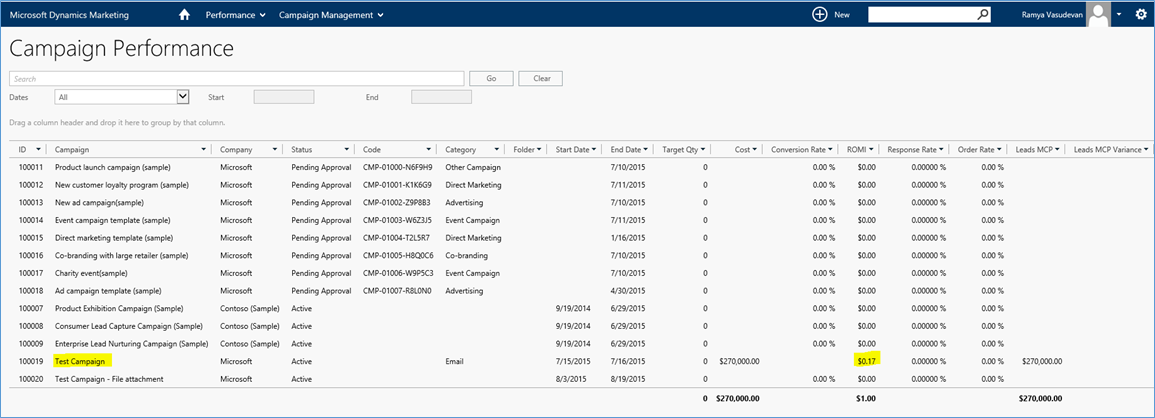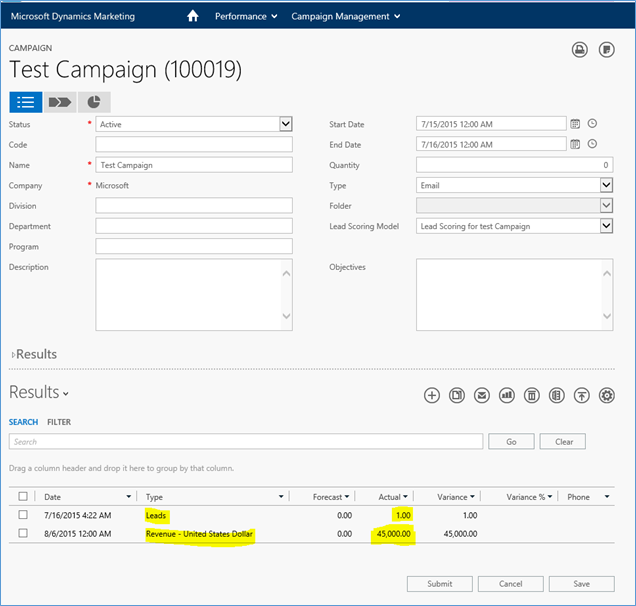ROMI calculation in Microsoft Dynamics Marketing (MDM)
As a strong proponent of the CRM-MDM integrated scenario, I was trying to create a simple use case to help our customers understand the true benefits of this integration. During customer demos, one of the scenarios you can showcase is this:
Its quarter/year-end and the company is planning to get its high-value prospects to purchase its product quickly. The marketing team plans to run a quick nurture campaign on these prospects and asks the sales team to come up with a list of high-value prospects. The sales team creates a marketing list in CRM (it could either be an excel import or marketing list creation within CRM) and saves it. The marketing list gets synced to MDM (In order for the marketing list sync to happen from CRM to MDM, modify the Marketing List form and add a new field named 'Sync enable'. This has to be set to 'Yes' for the automatic sync to happen). The marketing team gets the high-value prospect list in MDM and they run a marketing campaign on that list (including email, social media, landing page, etc.). They also set up campaign budgets and track their expenses against it. The nurture campaign generates some serious leads – people who are genuinely interested in purchasing immediately. Automatic lead scoring happens in MDM and based on the lead scores, the 'Sales Ready' leads are automatically moved to CRM for the sales people to engage with them (If you look at the lead scoring models, Settings > Lead Scoring and open an existing one, you will find an option to grade your leads based on their scores. If you have enabled MDM-CRM sync, only the leads that are in 'Sales Ready' grade will get automatically moved to CRM). The sales ready leads are now available in CRM and the sales people, after engaging with the leads, qualify the leads and create Opportunities. The Opportunities are then closed as 'Won' with their revenues updated. These Opportunity records in CRM get synchronized to the Opportunity records (or rather, creates new Opportunity records) in MDM. The marketing team takes a look at these Opportunities (in MDM) to understands the effectiveness of their campaign.
This scenario is quite easy to demo mainly because the marketing lists, Leads, Opportunities etc. get synchronized between MDM and CRM quite instantaneously. The only thing to note here is that the lead scoring model has to take into account the demo situation and have lower values for the 'Sales Ready' grade so the lead can be quickly moved into the CRM system.
The trouble happens when you try to figure out the ROMI (Return on Marketing Investment) from MDM. Most of the queries I get from my Partners and Customers are around ROMI calculation or managing the campaign budgets the finances. I had to do a lot of research and engage with the MDM Product Managers to understand how that part works in MDM and I thought others might also benefit from my learnings.
Here are some of the points that you might otherwise take for granted:
In MDM, the 2 areas where you could check the 'Revenue Actual' or ROMI.
Open the campaign, click on the entity-picker at the bottom and select 'Budgets' so that you get to see the revenue

Go to Campaign Performance Report where you get to see the complete metrics for your campaign


If you have to get the revenue values populated in these 2 areas, this is what you have to note:
MDM's budgeting capabilities mainly include managing the revenue cycle through sales orders and invoices. The 'Actual Revenue' numbers picked up by the budget workbooks associated with a campaign (the first image above) are based on the 'Invoices' created for the campaign and NOT revenue values in 'Opportunities'. So updating the revenue in the 'Opportunity' record and closing it as 'won' will not have any effect on the revenue. Invoice entities can be associated with campaigns/opportunities (in the Invoice dropdown in the campaign/opportunities page) or directly through Home > Budgeting > Receipts > Invoices. Once you create an Invoice, the next step is to record the payments to ensure that the actuals are recorded.

To make a payment, go to Budgeting > Accounts Receivable, and you will see a list of Invoices (Account Receivables). Select the relevant invoice (the invoice that is linked to the Campaign) and mention the payment details, Amount and the other mandatory fields.

Now, the revenue actual will start getting reflected in the Campaign Budget area (example: Image1)
The 'Revenue Actual' and the ROMI fields in Campaign performance report (second image from the top) are sourced from the 'Results' associated with a campaign. The creation of the 'Result' for Leads is automatic. However, creation of campaign Result for invoices/revenues needs an additional step. So, if you open the campaign and select 'Results' from the entity picker (drop down) at the bottom (see the image below), you will see that the 'number' of leads that got generated as part of the campaign are displayed there. But there will be no mention of the revenue generated by each lead who got converted into a Sale. As per the current design, this has to be added manually. So basically, if the marketers have to track the ROMI and Revenue actual for their campaigns, they should manually go ahead and add the generated revenue in the campaign. This could be done by clicking on the '+' symbol at the top and adding a new 'Revenue – United States Dollar' field. If there are more than one revenue values, you could import the list by clicking on the 'Upload' button.

The second point to note is that the campaign budget entities are not currently synced from MDM to CRM through the connector. So even if you set up the campaign budgets in MDM, the budget will not be synchronized to CRM. One way to report on the Amount attribute of an opportunity associated with a campaign would be through OData feeds which makes available the campaign-opportunity relationship.
If we take note of the above points, it should be easier to demo a very effective scenario of integration between Dynamics CRM and MDM. It helped me to a great extent, hope it helps you too!